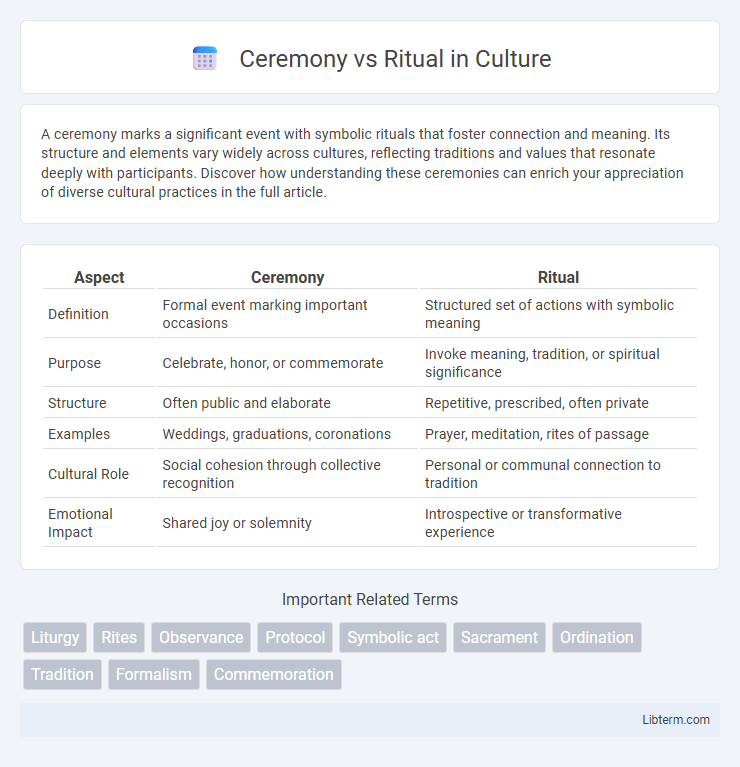A ceremony marks a significant event with symbolic rituals that foster connection and meaning. Its structure and elements vary widely across cultures, reflecting traditions and values that resonate deeply with participants. Discover how understanding these ceremonies can enrich your appreciation of diverse cultural practices in the full article.
Table of Comparison
| Aspect | Ceremony | Ritual |
|---|---|---|
| Definition | Formal event marking important occasions | Structured set of actions with symbolic meaning |
| Purpose | Celebrate, honor, or commemorate | Invoke meaning, tradition, or spiritual significance |
| Structure | Often public and elaborate | Repetitive, prescribed, often private |
| Examples | Weddings, graduations, coronations | Prayer, meditation, rites of passage |
| Cultural Role | Social cohesion through collective recognition | Personal or communal connection to tradition |
| Emotional Impact | Shared joy or solemnity | Introspective or transformative experience |
Understanding the Concepts: Ceremony and Ritual
Ceremony and ritual both involve structured actions and symbolic gestures that convey meaning within cultural or social contexts. Ceremony typically refers to formal events marked by established protocols, such as weddings or graduations, emphasizing collective participation and significance. Rituals are repetitive, often personal or spiritual practices that reinforce beliefs or traditions, ranging from daily habits to sacred rites.
Historical Origins of Ceremonies and Rituals
Ceremonies and rituals originate from ancient human societies where structured practices marked significant life events and cultural transitions. Ceremonies often evolved as formal public events linked to religious, political, or social authority, while rituals served as repetitive symbolic actions reinforcing communal beliefs. Archaeological evidence from Mesopotamia and ancient Egypt reveals early ceremonies tied to harvest cycles and coronations, reflecting the deep-rooted historical significance of these practices in human civilization.
Key Differences Between Ceremony and Ritual
Ceremonies are formal events with structured sequences, often public and celebratory, marking significant life or cultural milestones like weddings or graduations. Rituals involve prescribed actions or symbolic gestures performed consistently to convey meaning, reinforce beliefs, or invoke spiritual presence, typically within religious or cultural contexts. The key difference lies in ceremonies being broad social events, while rituals are specific, symbolic practices that may form part of those ceremonies or stand alone.
Cultural Significance of Ceremonies
Ceremonies hold profound cultural significance as structured events that reinforce communal identity and shared values through symbolic acts and formal traditions. They serve as pivotal moments in society, marking important life stages, historical milestones, or religious observances that connect individuals to their heritage and collective memory. The deliberate orchestration of ceremonies fosters social cohesion by uniting participants in meaningful experiences that transcend everyday routines.
Spiritual and Religious Importance of Rituals
Rituals hold profound spiritual and religious importance, serving as structured actions that connect individuals to divine forces and sacred traditions, reinforcing faith and communal identity. Unlike ceremonies, which may be more formal and public, rituals embody symbolic meaning and are often performed repeatedly to invoke spiritual presence or facilitate divine communication. These practices sustain religious beliefs, nurture spiritual growth, and foster a sense of transcendence within various faith communities.
Common Elements Shared by Ceremonies and Rituals
Ceremonies and rituals both involve structured sequences of actions performed with symbolic meaning, often marking significant life events or transitions. Shared elements include the use of specific attire, symbolic objects, designated locations, and often the presence of a community or audience to reinforce cultural or spiritual significance. These practices serve to create a sense of order, continuity, and collective identity across diverse cultures.
Modern Adaptations: Ceremonies vs Rituals Today
Modern adaptations of ceremonies often emphasize formal structure and public participation, serving social functions like marking significant life events or institutional milestones. Rituals today tend to focus on personal meaning and mindfulness, integrating symbolic actions into daily routines or wellness practices. Both ceremonies and rituals evolve with cultural contexts but differ in scale and intention, with ceremonies being more collective and rituals more individualized.
Psychological Impact on Participants
Ceremonies often create a structured social environment that promotes group cohesion and a shared sense of identity, enhancing emotional stability among participants. Rituals engage repetitive, symbolic actions which can reduce anxiety and foster a sense of control, aiding psychological resilience. Both ceremonies and rituals activate intrinsic meaning-making processes that support emotional regulation and reinforce cultural values.
Examples from Different Cultures and Traditions
Ceremonies such as Japanese tea ceremonies and Indian weddings exemplify formal events marked by prescribed rituals and social significance. Rituals, including the Navajo sand painting and the Hindu fire puja, involve symbolic actions performed in specific sequences to convey spiritual meaning or cultural values. Across cultures, ceremonies often incorporate rituals to establish community identity and commemorate important milestones.
Choosing Between a Ceremony and a Ritual
Choosing between a ceremony and a ritual depends on the intended purpose and emotional impact, as ceremonies typically involve formal, public events with structured sequences, while rituals focus on symbolic actions aimed at personal or communal meaning. Ceremonies often emphasize tradition and social acknowledgment, making them ideal for significant life events like weddings or graduations, whereas rituals offer customizable, intimate practices that reinforce beliefs or transitions. Understanding the context and desired connection helps determine if a ceremony's grandeur or a ritual's symbolism best suits the occasion.
Ceremony Infographic

 libterm.com
libterm.com